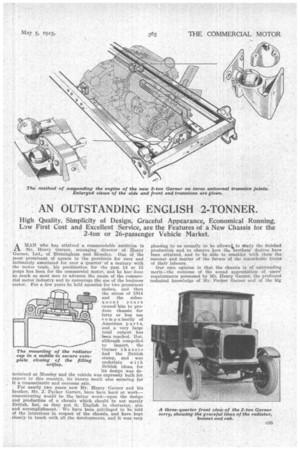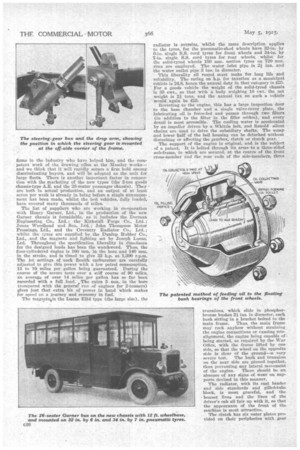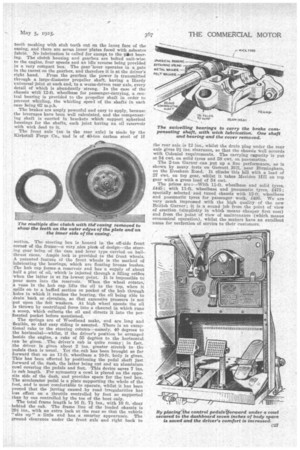• AN OUTSTANDING ENGLISH 2-TONNER.
Page 9

Page 10

Page 11

If you've noticed an error in this article please click here to report it so we can fix it.
High Quality, Simplicity of Design, Graceful Appearance, Economical Running; Low First Cost and Excellent Service, are the Features of a New Chassis for the 2-ton or 26-passenger Vehicle Market.
AMAN who has attained a commendable ambition is Mr. Henry Garner, managing director of Henry 'Garner, Ltd., of Birmingham and Moseley. One of the most prominent of agents in the provinces for cars and intimately associated for over a quarter of a century with The motor trade, his predilection for the past 14 or 15 years has been for the commercial motor, and he has done as much as most men to advance the cause of the commercial motor industry and to encourage the use of the business motor. For a few years he held agencies for two prominent makes, and then the stress of 1914 and the subsequent years caused him to produce chassis for lorry or bus use compulsorily of American part s, and a very large total output has been reached. But, although compelled to import, the Garner chassis had the British stamp, and was underlain with British ideas, for its design was determined at Moseley and the vehicle was expressly built for export to this country, its innate merit also securing for it a transatlantic and overseas sale.
For nearly two years now Mr. Henry Garner and his brother, Mr. J. Parker Garner, have been hard at work— concentrating would be the better word—upon the design and production of a chassis which should be not merely British, but, as they put it, English in character, aim and accomplishment. We have been privileged to be told of the intentions in respect of the chassis, and have kept closely in touch with all the developments, and it was very
1 IWO
r1,M17=1, WAN ere/147-0j1rArl
The mounting of the radiator cap in a saddle to secure complete closing of the filling orifice. pleasing to us recently to be allowed. to study the finished production and to observe how the 'brothers' desires have been attained, and to be able to consider with them the manner and matter of the future of the remarkable fruits of their labours.
Our own opinion is that the chassis is of outstanding merit—the outcome of the sound appreciation of users' requirements possessed by Mr. Henry Garner, the profound technical knowledge of Mr. Parker Garner and of the big firms in the industry who have helped him, and the competent work of the drawing office at the Moseley works— and wethink that it will rapidly secure a firm hold among discriminating buyers, and will be adopted as the unit for large fleets. There is another important factor in connection with the -marketing of the new types (the 2-ton goods chassis-type A.E. and the 26-seater passenger chassis). They are both in actual production, and an output of at least seven per week is already in being before a single announcement has been made, whilst the test vehicles, fully loaded, have covered many thousands of miles.
The list of suppliers who are working in co-operation with Henry Garner, Ltd., in the production of the new Garner chassis is formidable, as it includes the Dorman Engineering Co., Ltd.; the Kirkstall Forge Co., Ltd.; Jonas "Woodhead and Sou, Ltd.; John Thompson Motor Pressings, Ltd., and the Coventry Radiator Co., Ltd.; whilst the tyres are supplied by the Dunlop Rubber Co., Ltd., and the magneto and lighting set by Joseph Lucas, Ltd. Throughout the specification liberality in dirnefision for the designed loads has been the watchword. Thus, the four-cylindered engine is 100 mm. in the bore and 140 mm. in the stroke, and is timed to give 33 h.p. at 1,300 r.p.m. The jet settings of each Zenith carburetter are carefully adjusted to give this power with a low petrol consumption, 13 to 16 miles per gallon being guaranteed. During the course of the severe tests over a stiff course of 90 miles, an average of over 14 miles per gallon has so far been recorded with a full load. • The extra 5 ram. in the bore (compared with the general run of engines for 2-tonners) gives just that extra bit of power in hand which makes for speed on a journey and economy in fuel.
The ma,gnetys the Lucas EB4 type (the large size), the radiator is oversize, whilst the same description applies to the tyres, for the pneumatic-shod wheels have 32-in. by 6-in. single S.S. cord tyres for front wheels and 34-in, by 7-in. single S.S. cord tyres for rear wheels, whilst for the solid-tyred wheels 100 min. section tyres on 720 mm. rims are employed. The water inlet pipe is 21 ins, and the water outlet pipe 3 ins. in diameter.
This liberality all round must make for long life and reliability. The rating on h.p. for taxation as a municipal vehicle is 24.8, hence the annual duty in that category is £25. For a goods vehicle the weight of the solid-tyred chassis is 35 cwt., so that with a body weighing 10 cwt. the net weight is 21 tons, and the annual tax on such a vehicle would again be £25.
Reverting to the engine, this has a large inspection door to the base chamber and a single valve-cover plate, the lubricating oil is force-fed and passes through two filters (in 'addition to the filter in the filler orifice), and every detail is most accessible. The cooling water is accelerated by an impeller driven by a Whittle belt, and Behold silent chains are used to drive the subsidiary shafts. The sump and lower half of the bell housing can be detached without disturbing or affecting the gearbox, clutch or clutch gear.
The support of the engine is original, and is the subject of a patent. It is bolted through its arms to a three-sided sub-frame, to which are secured, at the centre of the front cross-member and the rear ends of the side-members, three trunnions, which slide in phosphorbronze bushes 2 ins, in diameter, each bush sitting' in a bracket bolted to the main frame. Thus, the main frame may rack anyhow without straining the engine connections or causing misalignment, the engine being capable of being started, as required by the War Office, with the frame lifted by one side, so that the wheel on the opposite side is clear of the ground—a very severe test. The bush and trunnion on the near side are pinned together, thus preventing any lateral movement of the engine. There should be an absence of any signs of wear on supports devised in this manner.
The radiator, with its cast header and side standards and gilled-tube block, is most graceful, and the bonnet lines and the lines of the driver's cab all fair up with it, so that the appearance of the front of the machine is most attractive.
The clutch has six outer plates provided on their peripheries with gear teeth meshing with stub teeth cut on the inner face of the casing, and there are seven inner plates faced with asbestos fabric. No lubrication is called for except to the pilot bearing. The clutch housing and gearbox are bolted unit-wise to the engine, four speeds and an idle reverse being provided in a very compact box. The gear'lever operates in a gate in the turret on the gearbox, and therefore it is at the driver's right hand. From the gearbox the power is transmitted through a large-diameter propeller shaft, having a Hardy universal joint at each end, to a worm-driven rear axle, every detail of which is abundantly strong. In the case of the chassis with 12-ft. wheelbase for passenger-carrying, a central bearing is provided to the propeller shaft in order to prevent whirling, the whirling speed of the shafts in each ease being 62 m.p.h.
The brakes are amply powerful and easy to apply, because the leverages have been well calculated, and the compensating shaft is carried in brackets which support spherical housings for the shafts, each joint having an oil reservoir 'with wick feed to it.
The front axle (as is the rear axle) is made by the Kirkstall Forge Co., and is of 40-ton carbon steel of II
section. The steering box is housed in the off-side front corner of the frame—a very nice pie ct of design—the steering gear being of the cam and lever type carried on ball-. thrust races. Ample lock is provided to the front wheels. A patented feature of the front wheels is the method of lubricating the bearings, which are floating bronze bushes. The hub cap forms a reservoir and has a supply of about half a Dint of oil, which is injected through a filling orifice when the latter is at its lowest point. It is impossible to pour more into the reservoir. When the wheel rotates, a vane in the hub cap lifts the oil to the top, when it spills on to a baffled section or pocket of the hub through holes in which it reaches the bearing, the oil being able to drain back or circulate, so that excessive pressure is not put upon the felt washers. At high wheel speeds the oil is thrown by centrifugal force into a channel in which runs a scoop, which collects the oil and directs it into the perforated pocket before mentioned.
The springs are of Woodhead make, and are long and flexible, so that easy riding is assured. There is an exceptional rake to the steering column—namely, 40 degrees to the horizmital—whilst, if the driver's position be arranged beside the engine, a rake of 55 degrees to the horizontal can be given. The driver's cab is quite roomy ; in fact, the driver is given about 2 ins, greater stretch to the pedals than is usual. Yet the cab has been brought so far forward that on an 11-ft. wheelbase a 10-ft. body is given. This has been effected by positioning the pedal shaft just forward of the dash, the latter being cut and an aluminium cowl covering the pedals and feet. This device saves 7 ins. in cab length. For symmetry a cowl is placed on the opposite side of the dash, and provides space for the tool box. The accelerator pedal is a plate supporting the whole of the foot, and is most comfortable to operate, whilst it has been proved that the jarring caused by road irregularities has less effect on a throttle controlled by foot so supported than by one controlled by the toe of the boot only.
The total frame length is 16 ft. 71i. ins., with 10 ft. clear behind the cab. The frame line of the loaded chassis is 291 ins., with an extra inch at the rear so that the vehicle " sits lip" a little and has a smarter appearance. The ground clearance under the front axle and right back to the rear axle is 12 ius., whilst the drain plug under the rear axle gives 91 ins, clearance, so that the chassis Well accords with Colonial requirements. The carrying capacity is put at 54 cwt. on solid tyres and 58 cwt. on pneumatics.
The 2-ton Garner can put up a fine performance, as is shown by many tests on Gorcott Hill, near Birmingham, on the Evesham Road. It climbs this hill with a load of 27 cwt. on top gear, whilst it takes Meriden Hill on top gear with a gross load of 54 cwt.
The prices are :—With 11-ft. wheelbase and solid tyres, 1445; with 11-ft. wheelbase and pneumatic tyres, £415; specially selected and tuned chassis with 12-ft. wheelbase and pneumatic tyres for passenger work, £495. We are very much impressed with the high quality of the new British Garner ; it is a sound job from the point of view of erection (simplicity in which means cheaper first cost) and from the point of view of maintenance (which means economical operation), whilst the makers have an excellent name for nerfection of service to their customers.
































